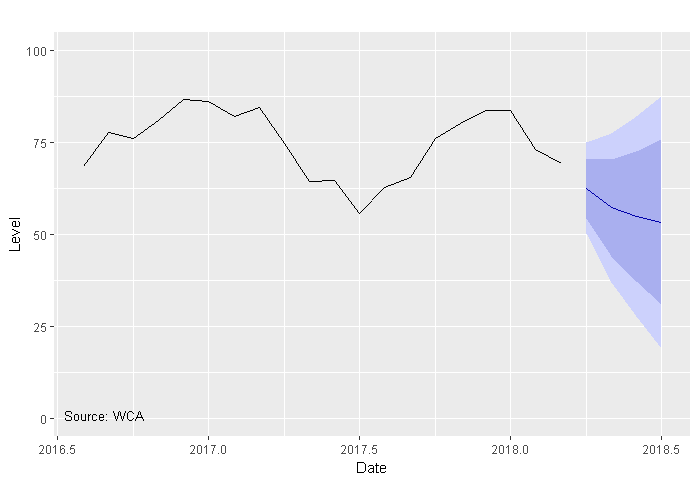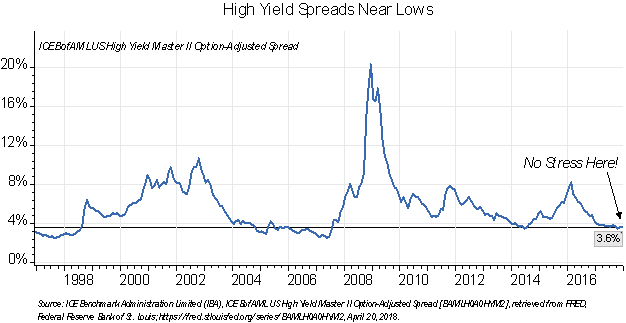Monday Morning Minute 042318
The WCA barometer holds steady through April, tactical stock / bond mix unchanged.
MACROECONOMIC INSIGHT
The last month’s data show signs of resilience following a sharp spike in volatility in February and March. The WCA Fundamental Condition Barometer (Graph 1, below) shows a forecast path that remains above 50, but is declining. Our forecast base case is unchanged from last month, suggesting some stability after some weakening trends in February-March. Thus the near-term prospects for continued growth are good, but some moderation looks reasonable. This forms the primary justification for our near-term view to be tactically overweight equities in asset allocation portfolios.
Graph 1
WCA Fundamental Conditions Barometer for March 2018
As a reminder, this process blends together more than two dozen individual indicators including financial market trends, domestic economic data, and foreign inputs. Our models assess the direction of each input and distill all of the observed trends into one number. The job of the barometer is to provide an unbiased answer to the question “Which way are trends generally pointing?” When we view sustained movements in one direction or another, across a wide field of observed indicators, we will take action in portfolios by shifting the mix of assets toward stocks and away from bonds, and vice-versa. In short, our tactical positioning tends to be more fact-based than opinion-based.
With our barometer’s base case forecast (black line in forecast range) no different than last month’s, it tells us a few things. First, without further deterioration in risk appetite or incoming data, a near-term recession is less likely. Second, it implies that higher interest rates and trade tensions have not yet hurt the economy’s “animal spirits.” Lastly, it hints at the possibility of a moderating but steady growth scenario, which could allow for an extended period of non-inflationary growth.
High Yield: Canary in the Coal Mine?
Separately, we continue to closely watch spreads in the corporate bond and high-yield market as another test of investor confidence. A 20% rise in S&P 500 profit forecasts, combined with an expectation for significant repatriated funds from abroad, are encouraging signs for investors in credit and corporate bonds. The bottom chart, for example, shows the spread versus U.S. Treasuries for high-yield (risky) corporate bonds. As you can see, these bonds trade with very little additional yield versus Treasuries today when compared to the typical spread in the past. The current spread stands near 3.6%, closer to the low-end of the historic range.
Graph 2
Conclusion
While tight corporate spreads may reduce the relative attractiveness of high-yield bonds compared to Treasuries, they also point to sustained investor confidence in the face of higher volatility. As long as such confidence remains intact, relatively inexpensive financing for new projects should remain available. This availability of cheap capital, in turn, could keep the music playing for a time longer.
Because the forecast path of our barometer stabilized since last month’s update, we are making no adjustments to equity exposure in tactical portfolios at this time.
ECONOMIC DATA THIS WEEK
| Date | Report | Period | Survey | Prior |
| Mon, Apr 23: | PMI Composite Flash | Apr | 54.3 | |
| PMI Manufacturing Flash | Apr | 55.7 | ||
| PMI Services Flash | Apr | 54.1 | ||
| Existing Home Sales M/M | Mar | 3.0% | ||
| Existing Home Sales Y/Y | Mar | 1.1% | ||
| Tues, Apr 24: | New Home Sales | Mar | 618K | |
| Consumer Confidence | Apr | 127.7 | ||
| S&P Case-Shiller HPI SA M/M | Feb | 0.8% | ||
| S&P Case-Shiller HPI NSA M/M | Feb | 0.3% | ||
| S&P Case-Shiller HPI NSA Y/Y | Feb | 6.4% | ||
| Wed, Apr 25: | No Economic Data | |||
| Thurs, Apr 26: | Weekly Jobless Claims | 4/21 | 232K | |
| Durable Goods New Orders M/M | Mar | 3.1% | ||
| Durable Goods New Orders Y/Y | Mar | 8.9% | ||
| Durable Goods Ex-Trans M/M | Mar | 1.2% | ||
| Durable Goods Ex-Trans Y/Y | Mar | 8.1% | ||
| Core Capital Goods M/M | Mar | 1.8% | ||
| Core Capital Goods Y/Y | Mar | 8.0% | ||
| International Trade Balance | Mar | -$75.4B | ||
| Exports % Change | Mar | 2.2% | ||
| Imports % Change | Mar | 1.4% | ||
| Fri, Apr 27: | Real GDP Q/Q | 1Q2018 | 2.9% | |
| Employment Cost Index Q/Q | 1Q2018 | 0.6% | ||
| Employment Cost Index Y/Y | 1Q2018 | 2.6% | ||
| Chicago PMI | Apr | 57.4 | ||
| Consumer Sentiment | Apr | 97.8 | ||
| Source: Bloomberg | ||||
ASSET ALLOCATION PORTFOLIO POSTURE
Based on our long-run capital market expectations, the “diversified core” allocation within portfolios is:
Overweight Foreign Developed equities vs. Emerging Markets
Overweight Domestic LG Cap Value vs. Growth
Neutral Duration and Credit vs. Target Exposure
Based on shorter-term expectations, the “tactical satellite” allocation within portfolios is:
Overweight Stocks vs. Bonds
WCA PORTFOLIO CHANGES LAST WEEK
No change
Added Merck & Co., Inc. (NYSE: MRK)
CONQUEST Asset Allocation Portfolios
No change
DYNAMIC STRATEGIES Asset Allocation Portfolios
No change
No change
Kevin Caron, CFA, Senior Portfolio Manager
Chad Morganlander, Senior Portfolio Manager
Matthew Battipaglia, Portfolio Manager
Suzanne Ashley, Analyst
973-549-4168
www.washingtoncrossingadvisors.com
Disclosures
WCA Fundamental Conditions Barometer Description: We regularly assess changes in fundamental conditions to help guide near-term asset allocation decisions. The analysis incorporates approximately 30 forward-looking indicators in categories ranging from Credit and Capital Markets to U.S. Economic Conditions and Foreign Conditions. From each category of data, we create three diffusion-style sub-indices that measure the trends in the underlying data. Sustained improvement that is spread across a wide variety of observations will produce index readings above 50 (potentially favoring stocks), while readings below 50 would indicate potential deterioration (potentially favoring bonds). The WCA Fundamental Conditions Index combines the three underlying categories into a single summary measure. This measure can be thought of as a “barometer” for changes in fundamental conditions.
The information contained herein has been prepared from sources believed to be reliable but is not guaranteed by us and is not a complete summary or statement of all available data, nor is it considered an offer to buy or sell any securities referred to herein. Opinions expressed are subject to change without notice and do not take into account the particular investment objectives, financial situation, or needs of individual investors. There is no guarantee that the figures or opinions forecasted in this report will be realized or achieved. Employees of Stifel, Nicolaus & Company, Incorporated or its affiliates may, at times, release written or oral commentary, technical analysis, or trading strategies that differ from the opinions expressed within. Past performance is no guarantee of future results. Indices are unmanaged, and you cannot invest directly in an index.
Asset allocation and diversification do not ensure a profit and may not protect against loss. There are special considerations associated with international investing, including the risk of currency fluctuations and political and economic events. Investing in emerging markets may involve greater risk and volatility than investing in more developed countries. Due to their narrow focus, sector-based investments typically exhibit greater volatility. Small company stocks are typically more volatile and carry additional risks, since smaller companies generally are not as well established as larger companies. Property values can fall due to environmental, economic, or other reasons, and changes in interest rates can negatively impact the performance of real estate companies. When investing in bonds, it is important to note that as interest rates rise, bond prices will fall. High-yield bonds have greater credit risk than higher-quality bonds. The risk of loss in trading commodities and futures can be substantial. You should therefore carefully consider whether such trading is suitable for you in light of your financial condition. The high degree of leverage that is often obtainable in commodity trading can work against you as well as for you. The use of leverage can lead to large losses as well as gains.
All investments involve risk, including loss of principal, and there is no guarantee that investment objectives will be met. It is important to review your investment objectives, risk tolerance and liquidity needs before choosing an investment style or manager. Equity investments are subject generally to market, market sector, market liquidity, issuer, and investment style risks, among other factors to varying degrees. Fixed Income investments are subject to market, market liquidity, issuer, investment style, interest rate, credit quality, and call risks, among other factors to varying degrees.
This commentary often expresses opinions about the direction of market, investment sector and other trends. The opinions should not be considered predictions of future results. The information contained in this report is based on sources believed to be reliable, but is not guaranteed and not necessarily complete.
The securities discussed in this material were selected due to recent changes in the strategies. This selection criteria is not based on any measurement of performance of the underlying security.
Washington Crossing Advisors LLC is a wholly owned subsidiary and affiliated SEC Registered Investment Adviser of Stifel Financial Corp (NYSE: SF).





